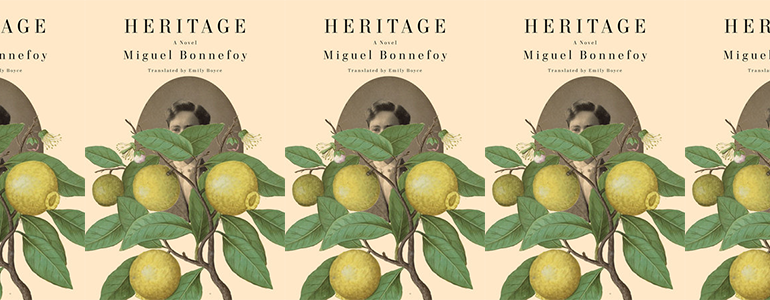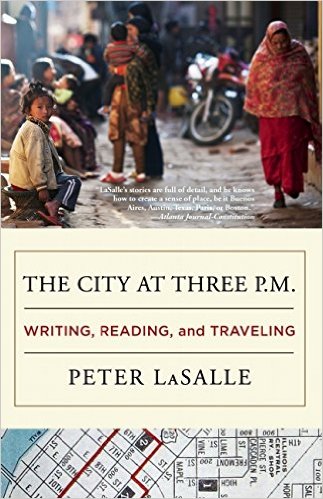Surreal and Ordinary Torture in Miguel Bonnefoy’s Heritage

Heritage
Miguel Bonnefoy, translated by Emily Boyce
Other Press | May 31, 2022
Heritage, Miguel Bonnefoy’s third novel, follows a family spanning four generations over one hundred years and two countries, Chile and France. Beginning with the War of the Pacific and ending in the torture chambers of the Pinochet regime, the novel also covers both world wars, the charnel ground of the Marne, and the Battle for Britain. Gracefully translated from the French by Emily Boyce and sparse in length, Heritage is also an homage to Garcia Marquez’s One Hundred Years of Solitude, and, at times, an imitation too.
Seeking the beguilements of Garcia Marquez’s magical realism without its labyrinthine storytelling and many characters, Bonnefoy recounts in his brief first chapter not only the paterfamilias’s flight from France to Chile after a phylloxera blight on his Jura vineyard but also the return journey of his three sons to fight in the first world war. Two sons die; one son is greviously wounded. The survival of the third son, Lazare Lonsonier, is the result of a betrayal of a Chilean neighbor, as he fights for his family’s own native Germany. To save his skin and maintain his loyalty to the idea of France, Lazare betrays his neighbor.
A big story is thus condensed into a few brief pages. From the outset, we learn the bare outline of the Lonsonier family’s trials and tribulations and understand that betrayal is inevitable in order to survive. Cataclysmic events—ecological disaster, plague, diaspora, war—buffet these characters before we’ve gotten their names straight. In fact, the family itself does not know its own name because Lonsonier is actually the French village (Lons-le-Saunier) that the original immigrant fled from. Not speaking Spanish, he misunderstands the immigration officer’s question upon his arrival in Chile and so is rechristened. His destination, too, is arbitrary, for Lonsonier is headed for California and lands in Chile only because he has been kicked off the ship for illness. Heritage then is both something profound—the family through the generations feels itself French to the core—and confused as well.
Though heritage is blurred, Bonnefoy’s writing is tactile and exact. For example, in one scene, Lazare soaks in a lemon-scented bath as he learns of the far away war in France that began two months before. In its sensuality and evocation of a past and future infused present, the prose recalls that of Garcia Marquez’s while being considerably less baroque. Reminiscent of Garcia Marquez, too, is the way in which the surreal is fused with the ordinary. A family of solitary individuals, the Lonsoniers wander through life as if through a dream, pursuing their interests single-mindedly: birds, planes, grapes, lovers, revolution. A newlywed woman fills her house with birds. An adolescent girl builds a plane in the front yard. Dinosaur bones are stored and forgotten on the kitchen shelves. A ghost becomes a father. A mother spirits her tortured son out of Chile in a homebuilt airplane so dysfunctional it might as well be fueled by hope. In the novel, the men are all wounded in some way, while the women are healers and stronger than their partners and sons. The extreme compression of the narrative, though, is in danger of making Heritage into just the episodic story of an eccentric family, not the epic in miniature that seems intended.
The novel’s final disaster, the atrocities of the Pinochet regime, again finds a callow young Lonsonier, as his forebears before him, caught up in political violence both surreal and mundane. Ilario Da, a writer in the making and dilettante revolutionary, is thrust into the living nightmare of being tortured for knowledge he doesn’t possess. Pinning the blame on another, a loyal family employee already tortured and murdered by the regime, Ilario Da opts for life rather than principle—the family way. His response is a very human one, but in the end, it is his privilege and his devoted mother who save him. “His dual identity as a bourgeois and militant was both frightening and exciting,” Bonnefoy writes of Ilario Da during the early heady days of the uprising against the Pinochet regime. Whether one can be both bourgeois and militant is a question the novel never answers. Hereditary wealth seems another kind of charm here, not the root of class struggle that leads to fascism.
In the end, a more powerful novel takes shape, less indebted to a literary tradition, less bound to the familiar tropes of twentieth-century European history. Here, Bonnefoy’s prose successfully bears unblinking witness to the sheer madness of torture.


